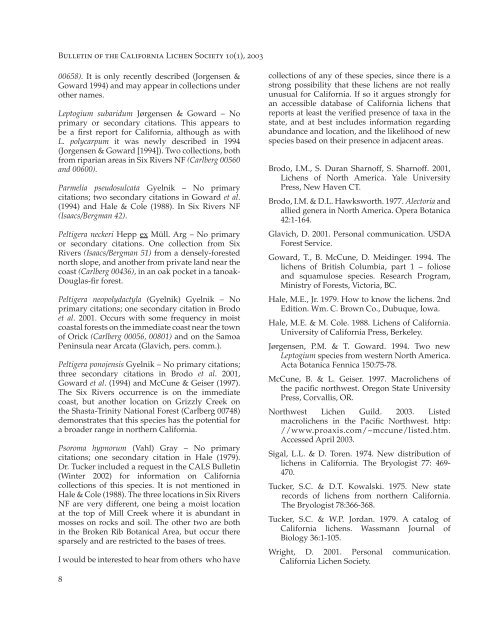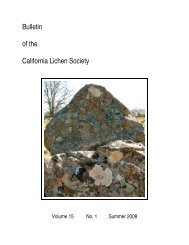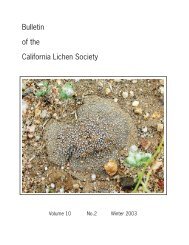Volume 10(1): Summer 2003 - The California Lichen Society (CALS)
Volume 10(1): Summer 2003 - The California Lichen Society (CALS)
Volume 10(1): Summer 2003 - The California Lichen Society (CALS)
Create successful ePaper yourself
Turn your PDF publications into a flip-book with our unique Google optimized e-Paper software.
Bulletin of the <strong>California</strong> <strong>Lichen</strong> <strong>Society</strong> <strong>10</strong>(1), <strong>2003</strong><br />
00658). It is only recently described (Jorgensen &<br />
Goward 1994) and may appear in collections under<br />
other names.<br />
Leptogium subaridum Jørgensen & Goward – No<br />
primary or secondary citations. This appears to<br />
be a first report for <strong>California</strong>, although as with<br />
L. polycarpum it was newly described in 1994<br />
(Jorgensen & Goward [1994]). Two collections, both<br />
from riparian areas in Six Rivers NF (Carlberg 00560<br />
and 00600).<br />
Parmelia pseudosulcata Gyelnik – No primary<br />
citations; two secondary citations in Goward et al.<br />
(1994) and Hale & Cole (1988). In Six Rivers NF<br />
(Isaacs/Bergman 42).<br />
Peltigera neckeri Hepp ex Müll. Arg – No primary<br />
or secondary citations. One collection from Six<br />
Rivers (Isaacs/Bergman 51) from a densely-forested<br />
north slope, and another from private land near the<br />
coast (Carlberg 00436), in an oak pocket in a tanoak-<br />
Douglas-fir forest.<br />
Peltigera neopolydactyla (Gyelnik) Gyelnik – No<br />
primary citations; one secondary citation in Brodo<br />
et al. 2001. Occurs with some frequency in moist<br />
coastal forests on the immediate coast near the town<br />
of Orick (Carlberg 00056, 00801) and on the Samoa<br />
Peninsula near Arcata (Glavich, pers. comm.).<br />
Peltigera ponojensis Gyelnik – No primary citations;<br />
three secondary citations in Brodo et al. 2001,<br />
Goward et al. (1994) and McCune & Geiser (1997).<br />
<strong>The</strong> Six Rivers occurrence is on the immediate<br />
coast, but another location on Grizzly Creek on<br />
the Shasta-Trinity National Forest (Carlberg 00748)<br />
demonstrates that this species has the potential for<br />
a broader range in northern <strong>California</strong>.<br />
Psoroma hypnorum (Vahl) Gray – No primary<br />
citations; one secondary citation in Hale (1979).<br />
Dr. Tucker included a request in the <strong>CALS</strong> Bulletin<br />
(Winter 2002) for information on <strong>California</strong><br />
collections of this species. It is not mentioned in<br />
Hale & Cole (1988). <strong>The</strong> three locations in Six Rivers<br />
NF are very different, one being a moist location<br />
at the top of Mill Creek where it is abundant in<br />
mosses on rocks and soil. <strong>The</strong> other two are both<br />
in the Broken Rib Botanical Area, but occur there<br />
sparsely and are restricted to the bases of trees.<br />
I would be interested to hear from others who have<br />
collections of any of these species, since there is a<br />
strong possibility that these lichens are not really<br />
unusual for <strong>California</strong>. If so it argues strongly for<br />
an accessible database of <strong>California</strong> lichens that<br />
reports at least the verified presence of taxa in the<br />
state, and at best includes information regarding<br />
abundance and location, and the likelihood of new<br />
species based on their presence in adjacent areas.<br />
Brodo, I.M., S. Duran Sharnoff, S. Sharnoff. 2001,<br />
<strong>Lichen</strong>s of North America. Yale University<br />
Press, New Haven CT.<br />
Brodo, I.M. & D.L. Hawksworth. 1977. Alectoria and<br />
allied genera in North America. Opera Botanica<br />
42:1-164.<br />
Glavich, D. 2001. Personal communication. USDA<br />
Forest Service.<br />
Goward, T., B. McCune, D. Meidinger. 1994. <strong>The</strong><br />
lichens of British Columbia, part 1 – foliose<br />
and squamulose species. Research Program,<br />
Ministry of Forests, Victoria, BC.<br />
Hale, M.E., Jr. 1979. How to know the lichens. 2nd<br />
Edition. Wm. C. Brown Co., Dubuque, Iowa.<br />
Hale, M.E. & M. Cole. 1988. <strong>Lichen</strong>s of <strong>California</strong>.<br />
University of <strong>California</strong> Press, Berkeley.<br />
Jørgensen, P.M. & T. Goward. 1994. Two new<br />
Leptogium species from western North America.<br />
Acta Botanica Fennica 150:75-78.<br />
McCune, B. & L. Geiser. 1997. Macrolichens of<br />
the pacific northwest. Oregon State University<br />
Press, Corvallis, OR.<br />
Northwest <strong>Lichen</strong> Guild. <strong>2003</strong>. Listed<br />
macrolichens in the Pacific Northwest. http:<br />
//www.proaxis.com/~mccune/listed.htm.<br />
Accessed April <strong>2003</strong>.<br />
Sigal, L.L. & D. Toren. 1974. New distribution of<br />
lichens in <strong>California</strong>. <strong>The</strong> Bryologist 77: 469-<br />
470.<br />
Tucker, S.C. & D.T. Kowalski. 1975. New state<br />
records of lichens from northern <strong>California</strong>.<br />
<strong>The</strong> Bryologist 78:366-368.<br />
Tucker, S.C. & W.P. Jordan. 1979. A catalog of<br />
<strong>California</strong> lichens. Wassmann Journal of<br />
Biology 36:1-<strong>10</strong>5.<br />
Wright, D. 2001. Personal communication.<br />
<strong>California</strong> <strong>Lichen</strong> <strong>Society</strong>.<br />
8





